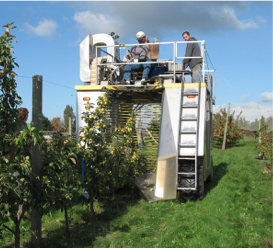Up until recently I’ve considered that developing a large scale cider orchard on dwarfing rootstocks is inviting trouble. Commercial eating apple orchards have progressively been planted on the more dwarfing rootstocks. This has been for various reasons: ease of management, ease of harvesting and earlier return on investment figure prominently. The downside is higher initial investment with more trees required per hectare and more infrastructure eg trellising or other support. If the return for cider can justify it, the hand picking of fruit from dwarf trees is vastly easier and quicker than from taller trees. Hand picking of early crops from dwarf trees is similarly justified so as not to compromise early tree training.
With most cider orchards the aim is not to have a particular form of tree but to produce consistent crops of apples for a low unit cost. This is where mechanical harvesting comes in. And mechanical harvesting is the default option for most of the English cider orchard operations. But then most English cider plantings are on semi-dwarf (or larger/stronger) rootstocks.
The issue with dwarf cider orchards is that until recently there seemed little likelihood of mechanical harvesting being feasible. With dwarf trees, conventional butt-shaking commonly causes tree damage, even to the extent of breaking the tree at the graft union or trunk/root junction. Work by Washington State University with modified over-the-row harvesters (one ex berryfruit) has produced good capture of fruit from the tree. If desired, earlier windfall fruit on the ground can be collected using conventional sweeping equipment. The over-the-row form of harvesting also has the advantage of not being a stop-start process that requires precise locating and gripping of butts so should also evolve into a quicker harvesting operation.
“Feasibility of Different Harvest Methods for Cider Apples: Case Study for Western Washington”
Suzette P. Gallinato, Carol A. Miles, . Travis R. Alexander
For the fresh fruit trade, such mechanically harvested fruit from the tree and from the ground would not be of acceptable quality – and hence not economic. But for apples that within hours will be scratted and pressed and on their way to becoming cider, the mechanical harvesting route is quite acceptable. It may also come about that the work being put into robotic fruit location and harvesting for the fresh fruit trade will reach the stage of feasibility. Whether the harvesting rate would match non-robotic rates is doubtful but the higher quality of robotic harvested fruit may well be desirable for certain juice or cider products.
Combine mechanical harvesting with over-the-row spraying that incorporates spray capture plus associated spray recycling and the orchard operations have a much better chance of meeting increasingly stringent environmental requirements. It will also bring savings for those same spraying operations both in operating time and chemical usage.
As an aside, there is debate about whether there are differences in amounts of flavour compounds, tannin etc in the outer (ie the skin and first few millimetres) of the apple fruit vs the bulk of the apple flesh. If this is so then it follows that small apples with a higher surface to volume ratio would contribute more to the final cider than do larger fruit. The issue here in trying to harness any advantage via small fruit is that hand harvesting small fruit is very labour intensive and therefore costly. This is obviously a dis-incentive to growing small fruited cultivars. Conversely the fruit size makes no difference to the mechanical harvester, leaving the choice of cultivar more open.

